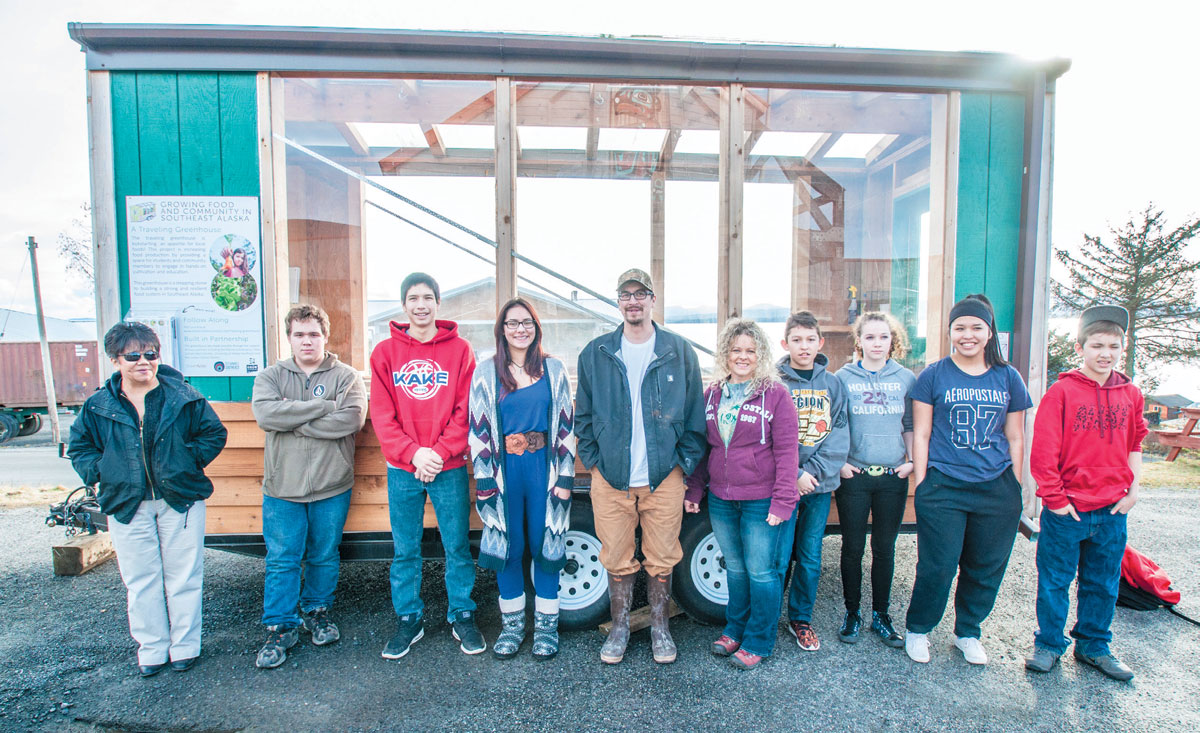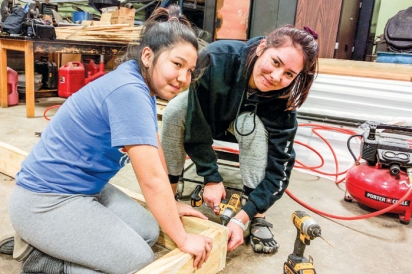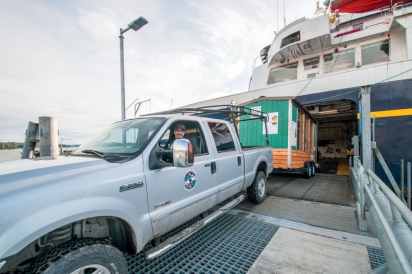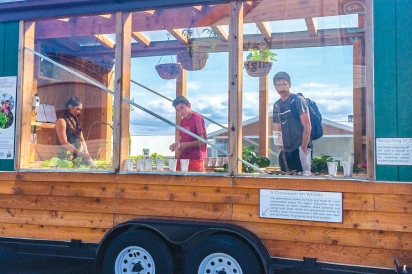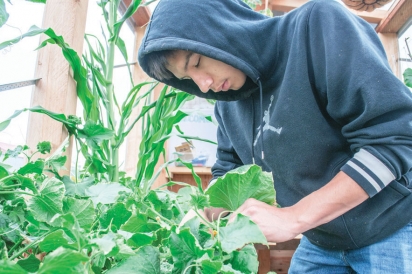Field Trip
On the Road with Moby, Alaska’s First Traveling Greenhouse
Puzzled drivers look on as the greenhouse cruises down Egan Drive toward the Juneau ferry terminal. There it is delicately backed down the ramp and on to the Alaska Marine Highway ferry. After a seven-hour journey through fjords and around the numerous islands of the Inside Passage, it touches down at its new summer home in Kake, a small coastal community of about 400 residents. In Kake the greenhouse is towed off the ferry and to the school where the Organized Village of Kake, the Southeast Alaska Regional Health Consortium, and students of Kake High School get to try out their green thumbs.
Meet Moby, Alaska’s first classroom greenhouse on wheels. Moby’s walls rise about ten feet high from an 18-foot long flatbed trailer. With clear polycarbonate walls and ceiling, a solar powered fan for ventilation, a water catchment system, sturdy wooden raised beds, and hanging baskets brimming with rich topsoil, the greenhouse is nearly an all-inclusive growing system. All Moby needs is now sun, water, seeds, and some TLC, and it comes to life.
The beauty of a traveling greenhouse is its mobility. Moby travels with a mission: to share knowledge and food production skills with schools, and to support healthy students while growing vibrant, sustainable, and food-secure Alaskan communities. It’s a steppingstone that helps communities whet their appetite for local foods by providing a space for students and community members to engage in hands-on cultivation and education.
Throughout the spring, summer, and fall, Kake residents will use the greenhouse to kickstart local food cultivation. “The availability of fruits and vegetables is a challenge, the stores are expensive. Additionally, energy is expensive and there are not many jobs,” says Jacquelin Bennum, a senior at Kake High School and the president of the newly formed Future Farmers of America (FFA) chapter here.
Moby’s visit to Kake is what prompted the group’s formation. “FFA and the greenhouse have taught me a lot about responsibility,” says Jacquelin. The FFA students oversee the planning, watering, weeding, thinning, and harvesting to maintain the greenhouse crops. “We have the opportunity to learn how to run a business. The greenhouse is a place where we can go to unite with people our age, to get to know each other, and get to know a little more about our wonderful land around us and how we can grow where we live,” says Jacquelin.
Cucumbers crawl up the windows, while squash, tomatoes, and giant Swiss chard burst from the beds. By late summer, Moby is full of life. and expanding its reach beyond the indoor space. Raised beds have been built outside, and the students are gaining skills and inspiration to grow food in the open air. “I learned how much water things need and how often I need to be up here. The rainy days I can pass by a day or two and it will still be moist,” reports Charles Duncan.
Charles is a 10th grader and the treasurer of the FFA in Kake. He harvests a handful of chard from the raised beds to reveal a couple of smaller plants growing underneath. “The plant I have to pay attention to the most is the chard, which absorbs the most water,” he says. A raised bed dedicated to chard is harvested by Jacquelin and Charles, and brought to the senior center to be shared with the elders for lunch. It’s a tradition in Kake to share the first harvest of the season. The rest of the day’s harvest is sold to raise funds for the FFA club.
Education, community, and student engagement have been priorities from Moby’s inception. The greenhouse was designed by Kaden Phillips, a University of Alaska Southeast student in the Construction Technology department. It was then built by Juneau Douglas High School students in their Basic Construction class using local cedar sourced from Icy Straits Lumber & Milling, based out of the nearby town of Hoonah. Juneau start-up AKReUse, a local company offering high-quality repurposed materials, also provided materials to construct Moby.
Kake is only the first stop for the traveling greenhouse. Each fall, rural communities in Southeast Alaska can apply to be Moby’s next home. Community partners are encouraged to submit applications and explain how using the greenhouse will help community food cultivation goals be realized.
The possibilities are endless – school gardening and farming allow the future leaders of Kake to recognize the potential for local food production. “It doesn’t mean we have to start big. Start small, slowly add on to it. Over time we could start an actual fresh business out of it,” says Jacquelin. Charles agrees, “What we planted has flourished and almost everything has grown. There is a giant possibility for something to happen. It is a great opportunity.”
Next spring Moby will be on the road again, with hopes of inspiring a new crop of Southeast Alaskan gardeners and farmers by planting seeds of awareness throughout the region.


